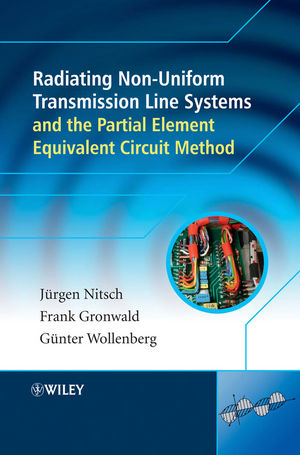Radiating Nonuniform Transmission-Line Systems and the Partial Element Equivalent Circuit MethodISBN: 978-0-470-84536-3
Hardcover
348 pages
December 2009
 |
||||||
Preface
Acknowledgments
List of Symbols
Introduction
1 Fundamentals of Electrodynamics
1.1 Maxwell Equations Derived from Conservation Laws - an Axiomatic Approach
1.2 The Electromagnetic Field as a Gauge Field - a Gauge Field Approach
1.3 The Relation Between the Axiomatic Approach and the Gauge Field Approach
1.4 Solutions of Maxwell Equations
1.5 Boundary Value Problems and Integral Equations
References
2 Nonuniform Transmission-Line Systems
2.1 Multiconductor Transmission Lines: General Equations
2.2 General Calculation Methods for the Product Integral/Matrizant
2.3 Semi-Analytic and Numerical Solutions for Selected Transmission Lines in the TLST
2.4 Analytic Approaches
References
3 Complex Systems and Electromagnetic Topology
3.1 The Concept of Electromagnetic Topology
3.2 Topological Networks and BLT Equations
3.3 Transmission Lines and Topological Networks
3.4 Shielding
References
4 The Method of Partial Element Equivalent Circuits (PEEC Method)
4.1 Fundamental Equations
4.2 Derivation of the Generalized PEEC Method in the Frequency Domain
4.3 Classification of PEEC Models
4.4 PEEC Models for the Plane Half Space
4.5 Geometrical Discretization in PEEC Modeling
4.6 PEEC Models for the Time Domain and the Stability Issue
4.7 Skin Effect in PEEC Models
4.8 PEEC Models Based on Dyadic Green's Functions for Conducting Structures in Layered Media
4.9 PEEC Models and Uniform Transmission Lines
4.10 Power Considerations in PEEC Models
References
Appendix A: Tensor Analysis, Integration and Lie Derivative
A.1 Integration Over a Curve and Covariant Vectors as Line Integrands
A.2 Integration Over a Surface and Contravariant Vector Densities as Surface Integrands
A.3 Integration Over a Volume and Scalar Densities as Volume Integrands
A.4 PoincarŽe Lemma
A.5 Stokes' Theorem
A.6 Lie Derivative
References
Appendix B: Elements of Functional Analysis
B.1 Function Spaces
B.2 Linear Operators
B.3 Spectrum of a Linear Operator
B.4 Spectral Expansions and Representations
References
Appendix C: Some Formulas of Vector and Dyadic Calculus
C.1 Vector Identities
C.2 Dyadic Identities
C.3 Integral Identities
Reference
Appendix D: Adaption of the Integral Equations to the Conductor Geometry
Appendix E: The Product Integral/Matrizant
E.1 The Differential Equation and Its Solution
E.2 The Determination of the Product Integral
E.3 Inverse Operation
E.4 Calculation Rules for the Product Integral
References
Appendix F: Solutions for Some Important Integrals
F.1 Integrals Involving Powers of square root x2 + b2
F.2 Integrals Involving Exponential and Power Functions
F.3 Integrals Involving Trigonometric and Exponential Functions
Reference
Index
Acknowledgments
List of Symbols
Introduction
1 Fundamentals of Electrodynamics
1.1 Maxwell Equations Derived from Conservation Laws - an Axiomatic Approach
1.2 The Electromagnetic Field as a Gauge Field - a Gauge Field Approach
1.3 The Relation Between the Axiomatic Approach and the Gauge Field Approach
1.4 Solutions of Maxwell Equations
1.5 Boundary Value Problems and Integral Equations
References
2 Nonuniform Transmission-Line Systems
2.1 Multiconductor Transmission Lines: General Equations
2.2 General Calculation Methods for the Product Integral/Matrizant
2.3 Semi-Analytic and Numerical Solutions for Selected Transmission Lines in the TLST
2.4 Analytic Approaches
References
3 Complex Systems and Electromagnetic Topology
3.1 The Concept of Electromagnetic Topology
3.2 Topological Networks and BLT Equations
3.3 Transmission Lines and Topological Networks
3.4 Shielding
References
4 The Method of Partial Element Equivalent Circuits (PEEC Method)
4.1 Fundamental Equations
4.2 Derivation of the Generalized PEEC Method in the Frequency Domain
4.3 Classification of PEEC Models
4.4 PEEC Models for the Plane Half Space
4.5 Geometrical Discretization in PEEC Modeling
4.6 PEEC Models for the Time Domain and the Stability Issue
4.7 Skin Effect in PEEC Models
4.8 PEEC Models Based on Dyadic Green's Functions for Conducting Structures in Layered Media
4.9 PEEC Models and Uniform Transmission Lines
4.10 Power Considerations in PEEC Models
References
Appendix A: Tensor Analysis, Integration and Lie Derivative
A.1 Integration Over a Curve and Covariant Vectors as Line Integrands
A.2 Integration Over a Surface and Contravariant Vector Densities as Surface Integrands
A.3 Integration Over a Volume and Scalar Densities as Volume Integrands
A.4 PoincarŽe Lemma
A.5 Stokes' Theorem
A.6 Lie Derivative
References
Appendix B: Elements of Functional Analysis
B.1 Function Spaces
B.2 Linear Operators
B.3 Spectrum of a Linear Operator
B.4 Spectral Expansions and Representations
References
Appendix C: Some Formulas of Vector and Dyadic Calculus
C.1 Vector Identities
C.2 Dyadic Identities
C.3 Integral Identities
Reference
Appendix D: Adaption of the Integral Equations to the Conductor Geometry
Appendix E: The Product Integral/Matrizant
E.1 The Differential Equation and Its Solution
E.2 The Determination of the Product Integral
E.3 Inverse Operation
E.4 Calculation Rules for the Product Integral
References
Appendix F: Solutions for Some Important Integrals
F.1 Integrals Involving Powers of square root x2 + b2
F.2 Integrals Involving Exponential and Power Functions
F.3 Integrals Involving Trigonometric and Exponential Functions
Reference
Index



